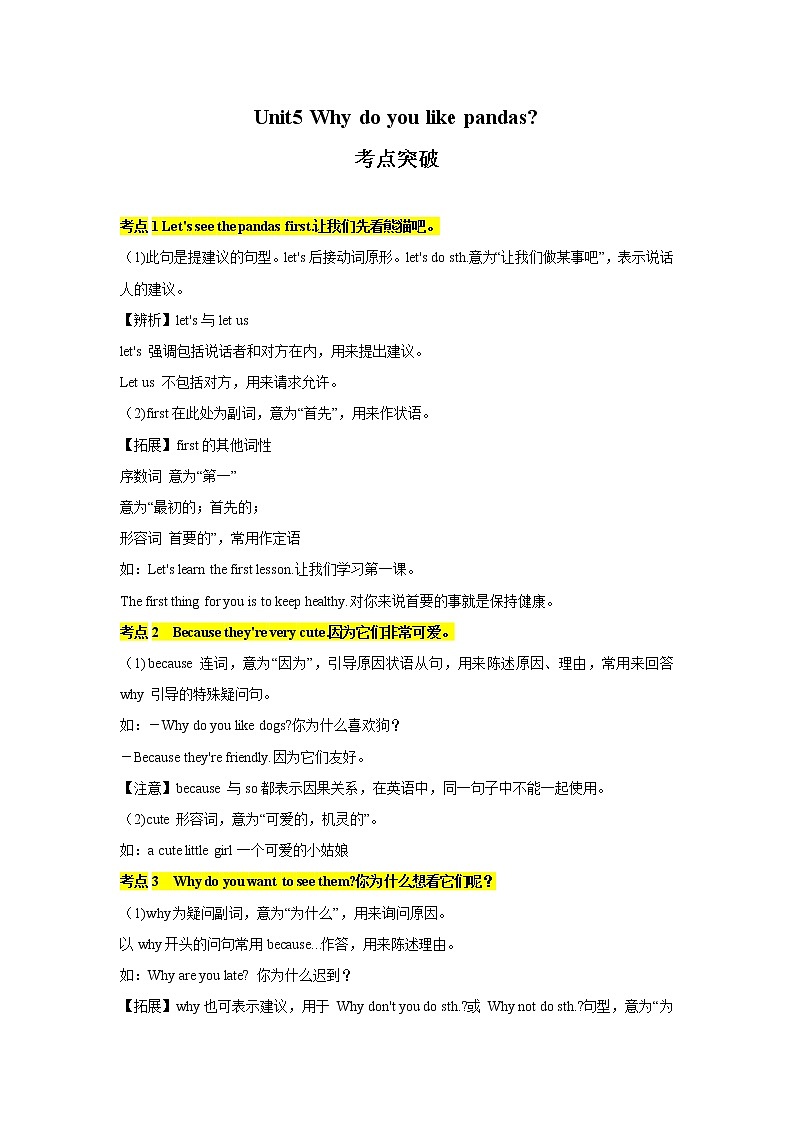

- unit3 核心考点-7年级下册教案 教案 8 次下载
- unit4 核心考点-7年级下册教案 教案 7 次下载
- unit6 核心考点-7年级下册教案 教案 7 次下载
- unit7 核心考点-7年级下册教案 教案 7 次下载
- unit8 核心考点-7年级下册教案 教案 7 次下载
unit5 核心考点-7年级下册教案
展开Unit5 Why do you like pandas?
考点突破
考点1 Let's see the pandas first.让我们先看熊猫吧。
(1)此句是提建议的句型。let's后接动词原形。let's do sth.意为“让我们做某事吧”,表示说话人的建议。
【辨析】let's与let us
let's 强调包括说话者和对方在内,用来提出建议。
Let us 不包括对方,用来请求允许。
(2)first在此处为副词,意为“首先”,用来作状语。
【拓展】first的其他词性
序数词 意为“第一”
意为“最初的;首先的;
形容词 首要的”,常用作定语
如:Let's learn the first lesson.让我们学习第一课。
The first thing for you is to keep healthy.对你来说首要的事就是保持健康。
考点2 Because they're very cute.因为它们非常可爱。
(1) because 连词,意为“因为”,引导原因状语从句,用来陈述原因、理由,常用来回答 why 引导的特殊疑问句。
如:-Why do you like dogs?你为什么喜欢狗?
-Because they're friendly.因为它们友好。
【注意】because 与so都表示因果关系,在英语中,同一句子中不能一起使用。
(2)cute 形容词,意为“可爱的,机灵的”。
如:a cute little girl一个可爱的小姑娘
考点3 Why do you want to see them?你为什么想看它们呢?
(1)why为疑问副词,意为“为什么”,用来询问原因。
以why开头的问句常用because...作答,用来陈述理由。
如:Why are you late? 你为什么迟到?
【拓展】why也可表示建议,用于 Why don't you do sth.?或 Why not do sth.?句型,意为“为什么不做某事呢?”。
(2)want to do sth.意为“想要做某事”,其中 want 相当于 would like.还可用于want sb.to do sth.“想让某人做某事”。
如:I want to buy two books. 我想要买两本书。
I want my teacher to buy two books for me.我想让我的老师为我买两本书。
考点4 kind of的用法
kind of 意为“有点儿;稍微”,是非常口语化的表达方式,常用来修饰形容词。
如:The dog is kind of cute.那只狗有点可爱。
【拓展】kind 可数名词,意为“种类”。
在英语中表示“一种事物”用a kind of;
表示“各种各样的”用all kinds of;
表示“许多种”用many kinds of;
表示“哪一种”用what kind of.
考点2 Where are they from?它们来自哪里?
be from意为“来自”,相当于 come from,后接表示地点的名词。
【辨析]be from与come from
be from | be是系动词,句式的变化是由be来完成的,而且be 有人称和数的变化
|
come from
| come是实义动词,句式的变化必须借助助动词 do/does来完成,且谓语动词come的单复数形式由主语决定 |
如:He isn't from China.他不是来自中国。
Li Ming comes from Shandong.李明来自山东。
Do they come from China? 他们来自中国吗?
考点5 Africa的用法
名词,意为“非洲”,其形容词为African,意为“非洲的;非洲人的”。
如:My friend is an African boy. He comes from South
Africa.我的朋友是一个非洲男孩,他来自南非。
【拓展】七大洲
Asia 亚洲;South America 南美洲;Europe 欧洲;Oceania大洋洲;Africa 非洲;
Antarctica 南极洲;North America 北美洲
考点6 He can walk on two legs.他会用两条腿走路。
walk on...意为“用某种方式行走”,其中on有“支撑住身体”的含义。
常用搭配还有 walk on one's hands“用手行走;倒立行走”;
walk on one's knees“跪着走”。
如:The children like to walk on their hands and knees. 孩子们喜欢在地上爬来爬去。
考点7 We are students from Thailand,and we want to save the elephants.
我们是来自泰国的学生,我们想拯救大象。
(1)from Thailand 介词短语,在句中作后置定语。
(2)save 动词,意为“救;救助”,后接名词或代词作宾语。
save one's life 意为“挽救某人的生命”。
【拓展】save 作动词的其他含义:
①保留;保存
如:You must save the important file.你必须保存那份重要的文档。
②节省;节约
如:People should save water.人们应该节约用水。
③储蓄;积攒
如:You should save a little each week.你每周都应该存点钱。
考点8 forget的用法
forget 动词,意为“忘记;遗忘”。常用搭配有:
forget to do sth. 忘记要做某事(事未做)
forget doing sth. 忘记做过某事(事已做)
【拓展】forget的反义词是remember,它们的用法相同。
考点9 Elephants can walk for a long time and never get lost.
大象能长时间行走并且从不迷路。
(1)for a long time 意为“长时间”。介词for后接时间段,表示动作或状态持续一段时间。
如:I can keep the book for two weeks.我可以借用这本书两周。
(2)lost 此处用作形容词,意为“迷路的”,常与连系动词get或be构成短语,即get/be lost,意为“迷路”,相当于lose one's way to
考点10 danger的用法
名词,意为“危险”,常构成短语
be in(great) danger处于(极大)危险之中;
Be out of danger 脱离危险。
考点11 cut的用法
(1)cut 动词,意为“砍;切”,其现在分词为 cutting, 过去式为cut.
(2)cut down 意为“砍倒”,
当宾语是代词时,只能位于cut和down之间,即cut it/them down“砍倒它/它们”。
考点12 We must save the trees and not buy things made of ivory.
我们必须挽救树木,不买象牙制品。
句中 made of...是过去分词短语作定语,修饰things.
unit12 核心考点-7年级下册教案: 这是一份unit12 核心考点-7年级下册教案,共4页。
unit11 核心考点-7年级下册教案: 这是一份unit11 核心考点-7年级下册教案,共4页。
unit8 核心考点-7年级下册教案: 这是一份unit8 核心考点-7年级下册教案,共4页。













